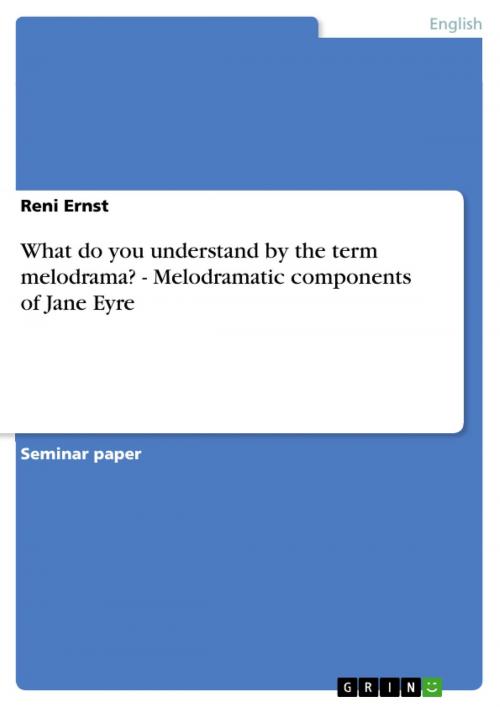What do you understand by the term melodrama? - Melodramatic components of Jane Eyre
Melodramatic components of Jane Eyre
Fiction & Literature, Literary Theory & Criticism, British| Author: | Reni Ernst | ISBN: | 9783638883931 |
| Publisher: | GRIN Publishing | Publication: | January 3, 2008 |
| Imprint: | GRIN Publishing | Language: | English |
| Author: | Reni Ernst |
| ISBN: | 9783638883931 |
| Publisher: | GRIN Publishing |
| Publication: | January 3, 2008 |
| Imprint: | GRIN Publishing |
| Language: | English |
Seminar paper from the year 2006 in the subject English Language and Literature Studies - Literature, grade: 1,0, University College Dublin (Faculty of Arts; School of English and Drama), 3 entries in the bibliography, language: English, abstract: In the following essay I will examine the term melodrama and its features. Accompanying I will give an account of the melodramatic components of the 19th century novel Jane Eyre by Charlotte Brontë. Both, melodrama and Jane Eyre, had their biggest impetus in the 19th century, thus have specific elements in common. Although Jane Eyre is not a drama to be played on stage it still concludes several melodramatic attributes, which will be specified after analyzing the term melodrama. The term melo originates from the Greek word melos, meaning music, which together with the annex drama simply refers to a stage play accompanied with music. Jean Jacques Rousseau is said to have firstly used a method of linking words with music in Pygmalion of 1770. In early 19th century use, melodrama referred to a stage play with interspersing songs and actors supported by music. By the end of the century the term had almost exclusively narrowed down to a dramatic piece marked by sensations, appeals to the emotions and a happy ending. Nevertheless music remained and still remains a crucial element to emphasize and intensify characters and scenes presented on stage and nowadays particularly in films. This musical element can also be found in the novels primarily of the 19th century expressed in a specific literary style, Brooks describes as follows:
Seminar paper from the year 2006 in the subject English Language and Literature Studies - Literature, grade: 1,0, University College Dublin (Faculty of Arts; School of English and Drama), 3 entries in the bibliography, language: English, abstract: In the following essay I will examine the term melodrama and its features. Accompanying I will give an account of the melodramatic components of the 19th century novel Jane Eyre by Charlotte Brontë. Both, melodrama and Jane Eyre, had their biggest impetus in the 19th century, thus have specific elements in common. Although Jane Eyre is not a drama to be played on stage it still concludes several melodramatic attributes, which will be specified after analyzing the term melodrama. The term melo originates from the Greek word melos, meaning music, which together with the annex drama simply refers to a stage play accompanied with music. Jean Jacques Rousseau is said to have firstly used a method of linking words with music in Pygmalion of 1770. In early 19th century use, melodrama referred to a stage play with interspersing songs and actors supported by music. By the end of the century the term had almost exclusively narrowed down to a dramatic piece marked by sensations, appeals to the emotions and a happy ending. Nevertheless music remained and still remains a crucial element to emphasize and intensify characters and scenes presented on stage and nowadays particularly in films. This musical element can also be found in the novels primarily of the 19th century expressed in a specific literary style, Brooks describes as follows:















